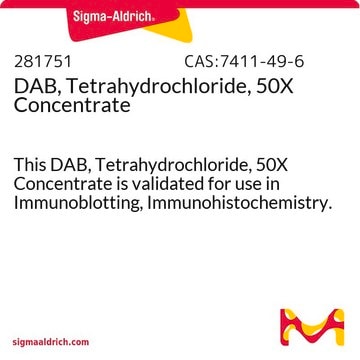11718096001
Roche
DAB Substrate
dark brown, /black precipitate; Visually evaluated
Synonym(s):
3,3′-diaminobenzidine tetrahydrochloride, DAB
About This Item
Recommended Products
manufacturer/tradename
Roche
Quality Level
color
dark brown, /black precipitate; Visually evaluated
storage temp.
−20°C
General description
3, 3′ diaminobenzidine tetrahydrochloride (DAB) is a carcinogen that should be used safely. It is one of the major sensitive substrates for HRP (horseradish peroxidase). DAB is brown or amber in color and becomes insoluble and precipitates over the antigen-antibody site due to the presence of hydrogen peroxide and peroxidase.
Application
- DAB Substrate is a color sustrate for peroxidases and is used in a variety of applications:Immunohistocytochemistry
- In situ hybridization
- Western blot
- Dot blot
Packaging
Preparation Note
- Determine the volume of substrate required for the development of peroxidase.
- Remove the DAB/metal concentrate (10x) from -15 to -25 °C storage.
Note: Do not bring to 15 to 25 °C. - Dilute the DAB/metal concentrate (10x) with the peroxide buffer to a 1x working solution. For example, if 5 ml of substrate are required, dilute 500 μl of the DAB/metal concentrate (10x) with 4.5 ml of the Peroxide buffer.
- Mix well.
- Add the 1x working solution to the tissue or blot until desired substrate development.
Note: The 1x solution is stable over many hours.
For best results, store the working solution at 2 to 8 °C when not using.
Storage conditions (working solution): 2 to 8 °C
For best results, store the working solution at 2 to 8 °C when not using.
Other Notes
Kit Components Only
- DAB/metal concentrate, 25 ml 10x concentrated
- Peroxide Buffer, 250 ml
Signal Word
Danger
Hazard Statements
Precautionary Statements
Hazard Classifications
Acute Tox. 3 Dermal - Acute Tox. 3 Inhalation - Acute Tox. 4 - Aquatic Chronic 2 - Carc. 1A - Carc. 1B - Flam. Liq. 2 Oral - Repr. 1B - Skin Sens. 1 Inhalation - STOT RE 2 - STOT SE 1
Storage Class Code
3 - Flammable liquids
WGK
WGK 3
Certificates of Analysis (COA)
Search for Certificates of Analysis (COA) by entering the products Lot/Batch Number. Lot and Batch Numbers can be found on a product’s label following the words ‘Lot’ or ‘Batch’.
Already Own This Product?
Find documentation for the products that you have recently purchased in the Document Library.
Customers Also Viewed
Our team of scientists has experience in all areas of research including Life Science, Material Science, Chemical Synthesis, Chromatography, Analytical and many others.
Contact Technical Service










